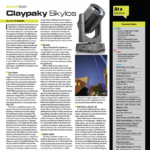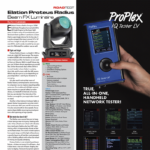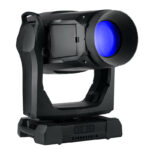Bright, but Not Blinding
Soft lights have often been used for front light in film, as the light source (bulb) in these fixtures is never directly exposed to the eye. Thus the actors or newscasters one sees on the screen are rarely squinting. The same theory applies with Ushio’s LED version of a soft light. The LEDs are mounted behind a white frosted screen, and I can’t see the individual LEDs no matter how hard I try. The panel emits a beam that is fairly wide. I am looking at the 1 x 2 model, which is twice as wide as tall. They also offer a square shaped 2 x 2. From six feet away, this fixture covers a 16-foot-wide area. The beam angle emitted is just under 120°.
On the back of the unit there’s an on/off switch as well as two adjustable knobs. I turn the power on and the left knob controls the intensity. The LCD screen on the back tells you the exact percentage of intensity you are at. The knob on the right controls the color temperature. Old school soft lights required the use of gels to adjust the color temperature emitted from the fixture. This is not a concern for the Pro Panel 2.
As soon as I touch the knob on the right, the LCD next to it tells me I am at 2700°. That’s as warm and CTO/tungsten-looking color as it gets. I appear to have a lovely tan on the camera at this level. As I raise the color temperature to an even 4200°, I resemble my normal self and skin tone on camera. The final daylight temperature of 6500°K is the top of its range. I measure the color temperature with my meter and match it with the setting on the back of the fixture. They are very close in readings. The fact that the gaffer on site can yell commands at you to bring it up a precise 5 points is easily achieved with this beauty. One can also store set values on the fixture as a preset.
Besides the IEC connector for AC, there are 5-pin XLR inputs and outputs for running the fixtures from a light console via DMX. As soon as I plug a DMX line into the fixture, it is smart enough to bypass the controls on the back. In other words, the console’s DMX values are overriding the potentiometer knobs used in manual operation. I address the fixture easily through the LCD monitor.
Two simple channels run this fixture, matching the knobs on the back. Running them via DMX is important if the fixtures are extended high on a stand for a shoot and one cannot reach the dials easily. Also on the back of the fixture is a 3-pin XLR connector for hooking the unit up to an external 24V DC battery. This is ideal for situations where one is working in remote locations with limited access to electricity. The yoke is made to be center mounted and adjustable via a tee handle on the side. The fixture can mount to any stand via ½-inch mounting hardware on the yoke. Of course, a C-clamp or half-coupler of any kind can hang the fixture. This model has new grip handles making it easy to handle. The grip handles also serve to protect the knobs in the back while in transport. The fixture is certified as UL, FCC and CE listed.
 2700°, 4200° and 5600°K
2700°, 4200° and 5600°K
At full intensity, this fixture is blasting out 100 watts and drawing less than 1 amp of current. The self-sensing power supply will recognize any voltage from 90-240 volts. From three feet away, I can blast this baby right into my eyes and not squint one bit, making it an ideal fixture for any photographer as well. From three feet away, I can measure an output of 205 foot-candles at 2700°K. From 10 feet away, it dips down to 32 foot-candles. The fixture does give off slightly more lumens when daylight temperatures are reached. Light sources with a high CRI (Color Rendering Index) are desired in applications that are color critical, such as filmmaking and photography. The Pro-Panel clocks in with a CRI of 95 out of 100, which is remarkable for an LED fixture. While looking at myself on camera, I find that in a dark studio, my skin tone looks best at around a 4200° setting. But if I walk in front of a lit video wall, the camera immediately makes me look dark. I raise the color temp up to a solid 5600°, and the optics on my camera even it all out flawlessly. I watch myself closely on a monitor as I adjust levels. The entire picture remains flicker free, even at higher speed frame rates.
Weighing in at a low weight of 12 pounds, this light appears to be solidly constructed of flat black aluminum. Accessories included with the fixture include a black 90° honeycomb louver one can place in front of the fixture to prevent sideways spill of light. There is also a gel frame should one wish get artsy with some light effects gel. For optional accessories, one can get a manual four-leaf barn door to control the shape of the beam. Ushio also offers a remote control unit that allows you to adjust the intensity and color temperature via a 4-pin XLR connector.
At a Glance
New and Improved
Ushio has stepped up their game with the release of the second version of the Pro Panel. It is brighter while maintaining a lower profile. It is more lightweight than its’ predecessor. The fixture is cool to the touch, silent and energy efficient. The yoke has been reworked making it more rigid with better handles to grip. The handles allow the fixture to be utilized as a hand held fixture for shining light in hard to illuminate places, during shoots.
Ushio Pro-Panel V2 Soft Light
PROS: Lightweight, perfect dimmer curve, readable color correction levels on LCD screen. Manual, DMX or remote control of the fixture
CONS: none
MSRP: $2,800 (1 x 2 model)
MORE INFO: www.ushio.com; www.plsn.me/UshioV2



